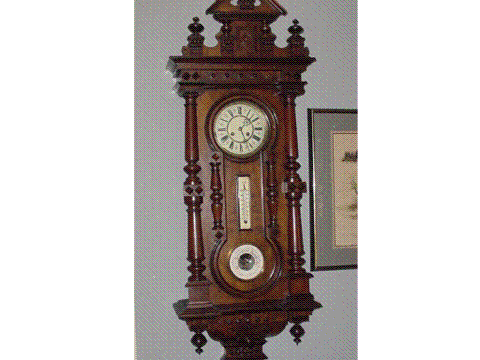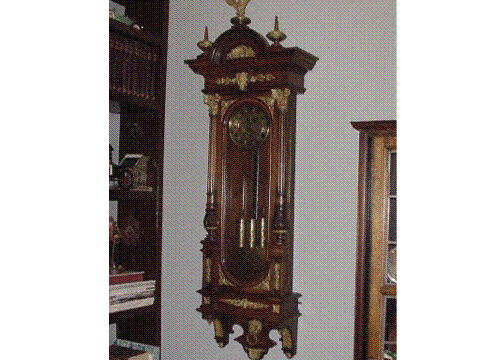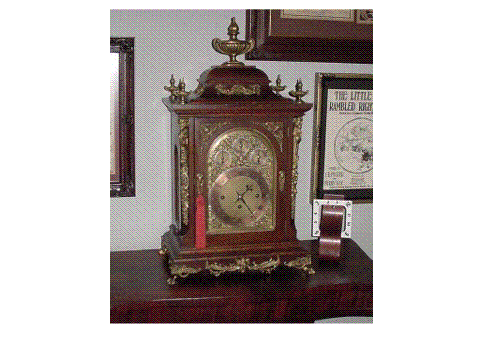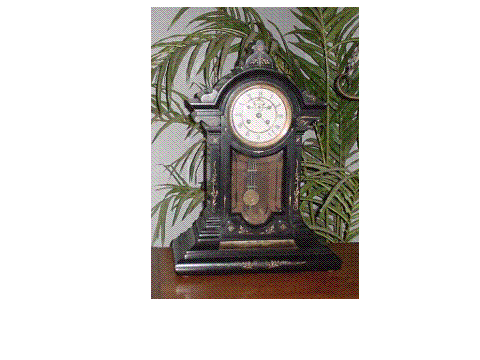Tick, tock. Tick, tock.
There's always room for one more clock!

Probably the first clock you see in our house is the "Fashion" by
Southern Calendar Clock Company, St. Louis, Missouri.
Inside, on the back of the door, is the original paper label:
"This clock and calendar is now set at one o'clock in the morning of August
1st, 1875. . . . Seth Thomas Clock Co., Thomaston, CT. It still
keeps very accurate time and it always knows the date and day of the week.
No adjustment to the calendar was required when we entered the year 2000.

One of our favorite clocks, this is a Gustav Becker Black Forest Regulator
that we found in Indiana a number of years ago.
Circa 1890, this clock is a key wind, 8-day spring driven, that chimes on
the hour and half-hour. A thermometer and barometer make this clock a
late 1800s weatherman.

This 8-day, triple-weight driven Vienna Regulator, Circa 1880, has a quarter-hour
gong strike and etched dial, weights and pendulum bob. Having a
"blind-man's strike", it chimes the hour and the quarter-hour.

Our very favorite is this 18th Century English Bracket Clock, circa
1780. The clock is key wound, has a triple dial, triple fusee
movement, and strikes the hour and quarter-hour on 9 nested bells. The
pull-cord on the lower left activates the blind man strike.
Its companion is a modern quartz movement made in Italy. To tell the
time, you read the clockwise rotating face disk.

This fancy Victorian clock made in Germany from black Belgian marble was awarded to a gentleman for
his service from 1869 to 1894. The clock continues to give service by
announcing time on the hour and the half-hour. Black Belgian marble is
said to be no
longer mined.

An English skeleton clock circa 1900 sits aside a similar vintage American
shelf clock made by Waterbury Clock Company.

Made by Standard Electric Clock Company, this Master clock came from the old
Madonna Hospital in Denison, Texas. Circa 1930, this clock drove
numerous Slave clocks throughout the hospital until it closed in the
1980s. Time to the slaves was adjusted every minute when the Master clock
rewinds.

This English cathedral clock circa 1910 is called a " Bim Bam" because of the sound it
makes when it strikes. Its strike has a very mellow resonance.

Circa 1860, this French Acorn Clock strikes the hour and half-hour, tells the
temperature and forecasts the weather with its "Barometre Anéroide".

This is a New Haven Clock Co. Crystal Regulator from around 1906. It
strikes on the hour and the half hour and has a mercury-type pendulum. The
little lady and bear inside are not original to the clock, but seem happy enough
to be there.

This dusty little clock was made by Kaiser in Germany in the 1940s. The
silver-colored "ball" in the center has numbers representing the hours
and minutes. The rotating numbers are read by sighting with the upright
red pointer. The bird is the pendulum.

This website created and managed with Microsoft© FrontPage
2000.
Original material and photographs in this website are © P
& S Morris, 2001.